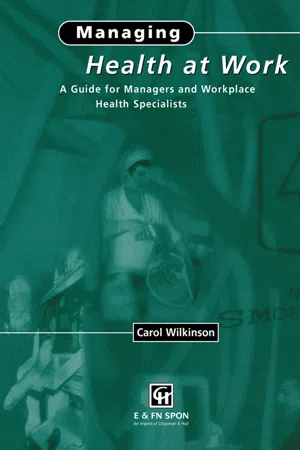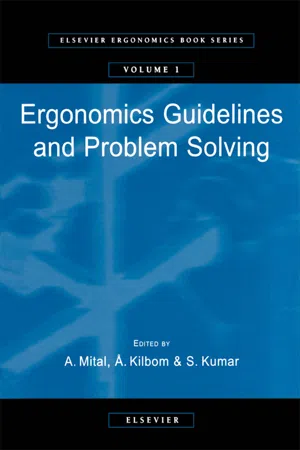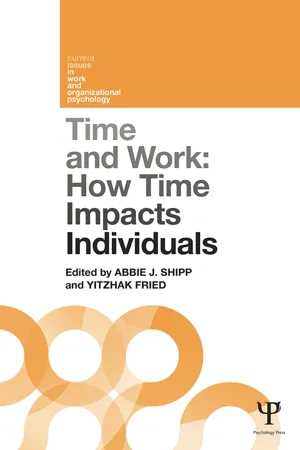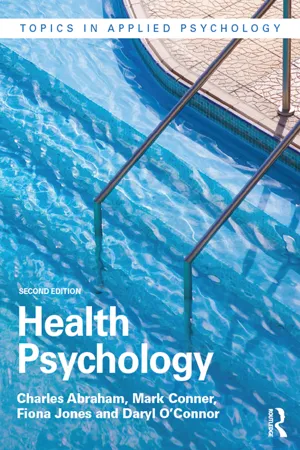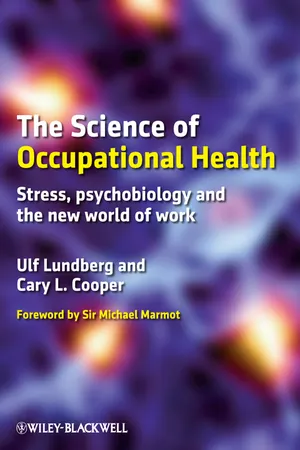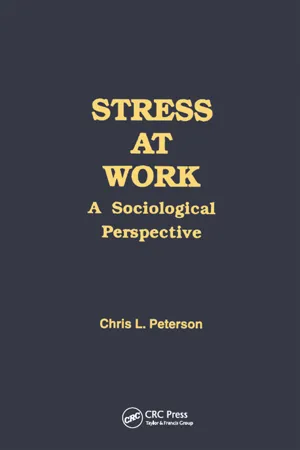Causes of Stress at Work
The causes of stress at work can include heavy workloads, tight deadlines, lack of control, poor management, interpersonal conflicts, and job insecurity. Other factors such as long hours, lack of work-life balance, and organizational changes can also contribute to workplace stress. It is important for businesses to address these factors to create a healthier and more productive work environment.
8 Key excerpts on "Causes of Stress at Work"
- eBook - ePub
- Jeremy Stranks(Author)
- 2005(Publication Date)
- Routledge(Publisher)
...People may experience a stress response due to: Difficulty in coping with change; Lack of confidence in dealing with interpersonal problems, such as those arising from aggression, bullying and harassment at work; Not being assertive enough, allowing other people to dominate in terms of deciding how to do the work; Not being good at managing time, frequently resulting in pressure from supervisors and other employees to ensure the task is completed satisfactorily and on time; and Lack of knowledge about managing stress. Some of the more common occupational stressors are shown in Table 2.1 above. Table 2.1 The more common occupational stressors New work patterns Increased competition New technology Longer hours Promotion Redundancy Relocation Early retirement Deregulation Acquisition Downsizing Merger Job design Manning levels Boredom Insecurity Noise Lighting Temperature Atmosphere/ventilation 2.2 Factors Contributing to Stress at Work Not all stress is caused by work. In many cases, people bring their stress to work, which may be associated, for example, with: Financial problems, in particular, debt Single parenthood Relationship problems, such as marital separation or impending divorce Other family problems, such as children being in trouble with the police or their school, a sick parent or a child leaving home Moving house A death in the family Having a baby or infertility problems Serious or terminal illness Impending retirement Problems with getting child care. In most cases, such persons are looking for a sympathetic response from their employer to their problems and many organizations now provide a range of support services, such as debt counselling, in addition to stress counselling for employees. 2.3 Categorizing the Causes of Stress Occupational stress is more easily understood if a distinction is made between its cause and effects...
- eBook - ePub
Managing Health at Work
A Guide for Managers and Workplace Health Specialists
- C. Wilkinson(Author)
- 2020(Publication Date)
- CRC Press(Publisher)
...We also need to look at other factors that impinge upon working life. For ease of explanation, factors associated with the causes of stress may be grouped as follows: The work environment. The job. The organization, culture and management styles. Factors intrinsic to work. THE WORK ENVIRONMENT HAZARDS The following is a series of factors which at times may be insufficiently or totally unregulated and which can lead to difficulties ranging from moderate discomfort to ill health. The building’s temperature is inadequate for normal functioning, i.e. too hot or too cold or fluctuating temperatures. Employees may lack protection from excessive noise (although protection is required under the Health and Safety at Work Act). There may be vibration present that interferes with regular activity. Poor or intense lighting can lead to mistakes being made in performing work tasks exposing individuals to accidents. Ventilation may be inadequate. There is exposure to toxic substances, chemicals, dust, gases and fumes. SMOKING A smoke-filled atmosphere can add to discomfort. Workplaces with unregulated smoking and with no agreed smoking policy is generally unsatisfactory to all. Smoking is both a cause and a result of stress. People under stress smoke more. Non-smokers in a smoky atmosphere can develop bad personal relationships and are distracted from their work. BUILDING CONDITION AND LAYOUT Buildings which are too old or poorly maintained, unsuitably designed, overcrowded and untidy are uncomfortable to work in and may also be a safety hazard. Work areas that are too small or overcrowded may not provide enough room to carry out the work properly and allow no privacy. Some layouts make workers feel cut off from each other and isolated...
- eBook - ePub
- A. Mital, Å. Kilbom, S. Kumar(Authors)
- 2000(Publication Date)
- Elsevier Science(Publisher)
...While there is abundant evidence that work performance is affected by such conditions as poor lighting, noise, heat, cold, glare, etc., stress is not commonly included in the explanation of the mechanism of the effect. Stress can, however, play a secondary role in this relationship (Poulton, 1978 ; Levi, 1987). For example, poor lighting is well-recognised to produce poor work performance, because it hampers the worker’s ability to gain enough information from the work environment to complete the task successfully. This then requires the individual to increase the amount of effort required to do the job, thereby increasing their level of stress and affecting work performance (Kahneman, 1973 ; Eysenck, 1983). A number of authors have attempted to develop lists of workplace risk factors for stress. One of the earliest was developed by Cooper and Marshall (1976), who grouped the sources of managerial job stress into six main groups shown in Table 2. Table 2 Sources of managerial job stress 1. Factors intrinsic to the job e.g.: working conditions such as those that demand fast paced work or high levels of physical energy as well as jobs which have high work load. 2. Role in the organisation e.g.: role ambiguity, role conflict and responsibility for staff or equipment. 3. Relationships at work e.g.: interpersonal relationships between workers and their supervisors, management and subordinates and colleagues in the work group. 4. Career development e.g.: job insecurity and status incongruity, and under or over-promotion. 5. Organisational structure and climate e.g.: little worker participation in decision making and restrictions on behaviour. 6. Extra-organisational sources of stress e.g.: competition between the demands of work and home or social life. (from Cooper and Marshall, 1979) The general models of stress in the workplace can also provide a framework for making predictions about which workplace factors are risk factors for stress...
- eBook - ePub
Time and Work, Volume 1
How time impacts individuals
- Abbie J. Shipp, Yitzhak Fried, Abbie J. Shipp, Yitzhak Fried(Authors)
- 2014(Publication Date)
- Psychology Press(Publisher)
...Typical task-related stressors include high time pressure and work overload, high complexity at work, monotonous work, and situational constraints that potentially compromise task performance (e.g., lack of information, poor tools, and problems with equipment). Role stressors comprise role overload (i.e., too much or too complicated work), role conflict (i.e., conflicting role expectations about what to do or how to do it), and role ambiguity (i.e., unclear role expectations; Katz & Kahn, 1978). A specific type of role conflict is the work-family conflict (Greenhaus & Beutell, 1985). Also, tasks that are perceived to be illegitimate can be seen as a role-related stressor (Semmer, Tschan, Meier, Facchin, & Jacobshagen, 2010). Social stressors result from poor social interactions with others. Typical social stressors include interpersonal conflicts with supervisors or coworkers, workplace aggression (e.g., (sexual) harassment, bullying), and demands originating from unpleasant interactions with customers. Career-related stressors comprise job insecurity, underemployment, and poor career opportunities. Traumatic stressors refer to single events that are particularly threatening or harmful such as disasters, major accidents, or extreme dangers. Finally, processes occurring during organizational change (e.g., downsizing, implementation of new technology, mergers) can also be considered as stressors. Strains Strains are an individual’s reactions to stressors. These reactions can occur at the physical, affective, and behavioral level and span a broad time horizon, ranging from immediate physiological responses to long-term impairments of physical and psychological health and well-being. Short-term physiological reactions include responses of the endocrinological (e.g., cortisol – Dickerson & Kemeny, 2004) and the cardiovascular systems (Ilies, Dimotakis, & De Pater, 2010). Many of these reactions occur immediately after the stressor occurred, without a major delay...
- eBook - ePub
- Charles Abraham, Mark Conner, Fiona Jones, Daryl O'Connor(Authors)
- 2016(Publication Date)
- Routledge(Publisher)
...4 Stress and health in context DOI: 10.4324/9781315776453-6 Chapter Plan Chapter 3 examined a range of different approaches to stress and considered the links between stress and health. In this chapter we look at the effect of environmental or contextual factors on stress and their relationship to health. In the first section, we consider the effect of socio-economic status (SES) and social inequality on stress and health. It is well established worldwide that poverty and deprivation are associated with poor health and that even within affluent societies lower SES is linked to poorer health. We consider the role of stress in this relationship. We then consider stress at work in a subsequent section. For most people, their job determines their income and therefore their SES. Indeed, researchers typically classify individuals into social classes based on their occupation using formal classification systems such as the UK National Statistics Socio-Economic Classification (NS-SEC; National Statistics, 2002). Most people spend a significant proportion of their lives at work and evidence suggests that many people feel that it is a major source of stress (Smith et al., 2000). Work stress is also of great interest to employers who need to have healthy and productive workforces. Work stress is also known to have implications beyond the work environment. If we feel stress at work this cannot always be easily switched off when we go home and similarly major problems in our personal lives may affect our work. Work stressors may impact even more on our home lives if we work long hours and take work home with us. Increasingly, the barriers between work and home are being eroded by new technology and changing working patterns (Major and Germano, 2006)...
- Terry Beehr(Author)
- 2014(Publication Date)
- Routledge(Publisher)
...Part II Stressors in the workplace This section describes the causal factors in occupational stress — the workenvironment stressors in Figure 1.2 from the first chapter. One chapterexamines the first two stressors to receive widespread attention in theorganizational psychology approach to job stress: role conflict and ambiguity.The majority of the chapter focuses on role ambiguity, because thatis where my research program focused from the start. In fact, my 1974 dissertation was entitled “Role ambiguity as a role stress: some moderatingand intervening variables.” Most organizational psychologists’ interests in role ambiguity and role conflict, including my own, can be traced to a 1964 book by Kahn et al. This work described both a large-scale US study and a simultaneous, smaller, intensive study of these two stressors in a variety of organizations. When a number of other researchers began to study job stress, about a decade later, this book seemed to be resurrected as the starting point for many of them. Because of its influence on many early investigations, it can be considered a pioneer work in the field. More studies have been done on these two stressors than on any others in the organizational psychology approach to occupational stress and they are therefore given a chapter of their own. As noted earlier, however, in my own research program role ambiguity has received more attention than role conflict. This is because I believed in the beginning, and still do, that the general concept of ambiguity (and uncertainty) is central to a great many organizational problems. It is unlikely that role conflict and role ambiguity are the entire story in occupational stress and fortunately, researchers have more recently begun to examine other types of workplace stressors...
- eBook - ePub
The Science of Occupational Health
Stress, Psychobiology, and the New World of Work
- Ulf Lundberg, Cary Cooper(Authors)
- 2010(Publication Date)
- Wiley-Blackwell(Publisher)
...Chapter 4 Work as a Source of Stimulation and Health or a Cause of Distress and Illness Work-Related Stress Models A number of models have been proposed in order to describe the factors that link work with stress-related disorders, and those that enable work to contribute to stimulation, well-being and health (Karasek & Theorell, 1990; Lundberg, 2007; Richter et al., 2007; Schnall et al., 2009). Frankenhaeuser (1986) and others have emphasised the importance of a reasonable balance between perceived work demands and the individual's perceived own resources to meet these demands. Karasek (1979) and Karasek and Theorell (1990) have formulated a model based on the relation between work demands and the possibilities for influence and control. In addition to the two original dimensions, social support has been included as a third dimension of this model (Johnson & Hall, 1988). A third model used to measure stress at work in many recent studies is the Effort–Reward–Imbalance model of Siegrist (1996). More recently, Ursin and Eriksen (2004) have formulated the Cognitive Activation Theory of Stress (CATS). CATS is based on formal logistic definitions of stress concepts, and can be applied to all forms of stress in humans and animals in order to predict positive and negative health outcomes. When the individual's perceived resources are in balance with the perceived demands, the work situation is considered to be stimulating and pleasant (Fig. 4.1). This model of work-related stress is based on the individual's perceptions, which means that imbalance and stress could be induced because an individual underestimates his or her actual resources or overestimates the anticipated demands. Low self-esteem is likely to increase the risk that even moderate work demands will induce stress in certain individuals...
- eBook - ePub
Stress at Work
A Sociological Perspective
- Chris Peterson(Author)
- 2018(Publication Date)
- Routledge(Publisher)
...Few studies have investigated the effects of partnership or number of children, although some studies have emphasized the need to account for effects of extraorganizational factors on work stress. Gender has been found to have some effect on stress (146). Variables in the second block are occupational position and length of time in the one position. Previous labor process research (e.g., 4, 5, 7) has shown that differences in occupational position reflect different levels of control experienced by employees, and have important effects on stress and ill-health outcomes. Caplan and associates (83) reported that the length of time spent in the one position had important effects on stress. These variables have been included in order to test the effects of control and levels of influence in the organization. The third block consists of negative work factors. A large amount of research has been reported (see Chapter 2) on the effects of negative work factors on stress and ill-health. A body of labor process literature as well as studies by Karasek (65, 66) and others have shown that lack of control has important effects. However, a variety of other work factors which also stem from a lack of control have been shown to have an important influence on stress and ill-health outcomes. These have been included in order to test the findings of a large body of research. The variables entered in the fourth block are stress, low self-esteem, and low personal mastery. A large amount of research, based primarily on the work of Selye (9, 15, 21), has shown stress to be an important determinant of ill-health. Research reported in Chapters 2 to 4 shows that stress is an outcome of preceding variables in the model (in particular negative work experience) and can lead to ill-health (e.g., 10, 65, 66). In addition, low self-esteem and low mastery have been found by writers such as Israel and coworkers (101) and Pearlin and Schooler (99) to have effects on ill-health outcomes...

